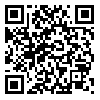BibTeX | RIS | EndNote | Medlars | ProCite | Reference Manager | RefWorks
Send citation to:
URL: http://hii.khu.ac.ir/article-1-2446-en.html
Background and Aim: The intellectual structure of knowledge and its research front can be identified by co-word analysis. This research attempts to reveal the intellectual structure of knowledge in information behavior inquiries, via co-word, network analysis, and science visualization tools.
Methods: Bibliometric methodology and social network analysis are used. Population comprises 2146 records in the field of Information Behavior during 2006-2014, which had been retrieved from Web of Science.
Results: finding indicate that “Information Retrieval” is the most frequent keyword in the Information Behavior inquiries. Also, “Information Needs and Information Behavior” are the most frequent co-occurred keywords. Use of hierarchical cluster analysis by Ward method led to the creation of 11 topical clusters in Information Behavior, including among others: “User Studies,” “Health Information Behavior,” and “Social Networks.”
Conclusions: The results indicated that the co-word analysis can be well uncover the intellectual structure of scientific disciplines. The results of the strategic diagram showed that “health information behavior”, “user studies”, “social networks”, and “relevance in information retrieval” are among well-matured and central clusters with pivotal role. Moreover, four clusters, including “information resources”, “Web search”, “information retrieval”, and “information management” are among emerging or declining clusters. Finally, although the “interface and information technology” cluster is in the central part, but it is underdeveloped. Due to the frequency of keywords on the one hand, and clusters obtained on the other hand, it seems to be a close relationship between information behavior and health studies. Therefore, it seem that many of information behavior studies have been conducted in health and medical communities
| Rights and permissions | |
 | This work is licensed under a Creative Commons Attribution-NonCommercial 4.0 International License. |






